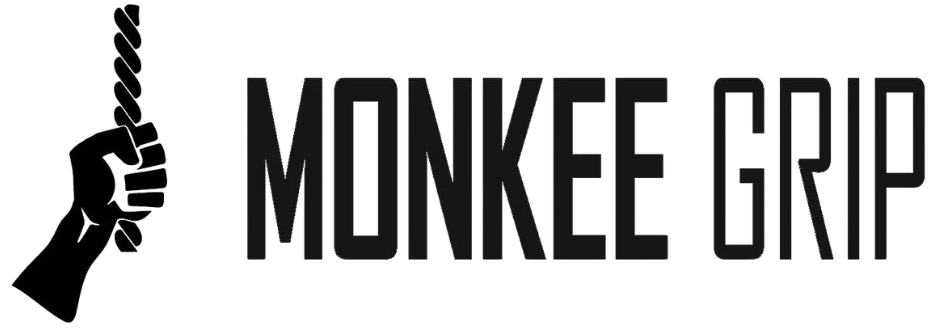Pull-Up Muscle Activation: Standard vs Rope-Based Grip Training
Pull-Up Muscle Activation: Standard vs Rope-Based Grip Training
Most people think a pull-up is just a pull-up—until they switch to a rope-based grip and suddenly feel muscles they didn’t even know they had. A standard bar pull-up is still one of the best bodyweight exercises on the planet. But when the grip changes from solid steel to friction-based rope, the movement goes from a controlled pull to a battle for stability, tension, and total-body coordination.
Today, we’re breaking down which muscles fire during a traditional pull-up—and how that activation explodes when you move to a rope-based variation like a Monkee Grip pull-up.
Standard Pull-Ups: The Classic 25-Muscle Power Move
On a traditional pull-up bar, you’re hanging from a solid, immovable surface. That stability allows the body to follow a predictable path of strength, primarily activating:
✅ Lats (latissimus dorsi) – main pulling force
✅ Biceps brachii & brachialis – elbow flexion
✅ Rhomboids & middle trapezius – scapular retraction
✅ Lower trapezius – scapular depression
✅ Brachioradialis – secondary elbow flexor
✅ Core (rectus abdominis, obliques) – light stabilization
That’s roughly 25 key muscles doing the majority of the work.
What’s missing:
⚪ Deep finger flexors
⚪ Wrist stabilizers
⚪ Forearm extensors
⚪ Rotator cuff muscles (infraspinatus, subscapularis)
⚪ Serratus anterior (scapular stabilizer)
⚪ Deep core stabilizers (transverse abdominis, internal obliques)
Your body only works as hard as it needs to—and a stable bar doesn’t force anything extra.
Why Rope-Based Grips Change Muscle Activation Completely
When you switch to rope-based grips like Monkee Grips, the bar stops helping you and your hands become responsible for friction. That completely changes how your muscles respond.
Every inch of the movement requires tension—not just from major muscle groups, but from stabilizers that normally relax on a bar. Even while hanging, you're constantly adjusting your grip and fighting rotation, which kicks in muscles that remain dormant in standard pull-ups.
In simple terms: rope grips create instability + friction demand, which forces the body to light up additional muscle groups as a survival response.
Rope Pull-Up Muscle Activation: A 40+ Muscle Chain Reaction
Here’s what gets significantly more engaged when you move to Monkee Grips:
🔥 Finger flexors (FDP, FDS) – prevent slipping
🔥 Forearm flexors & extensors – control micro-adjustments
🔥 Brachioradialis – activated harder under rotation
🔥 Wrist stabilizers – maintain neutral alignment
🔥 Rotator cuff – prevent shoulder rotation
🔥 Serratus anterior & lower traps – stabilize scapula
🔥 Transverse abdominis & obliques – prevent twisting
🔥 Deep spinal stabilizers – maintain full-body tension
Instead of 25 muscles working, rope grip pull-ups recruit over 40 muscles to stay in control.
Functional Strength > Isolated Strength
Bar pull-ups build strength in one predictable plane. Rope-based pull-ups build strength that can handle uncertainty. That’s why climbers, calisthenics athletes, MMA fighters, hockey players, and military personnel gravitate toward friction-based grip training—it creates strength that translates to performance when your body is tired, sweating, or off-balance.
More instability = more adaptation.
More friction demand = more tendon strength.
More muscle activation = more growth potential per rep.
Why Monkee Grips Are the Ideal Upgrade
Not all grip tools are equal. Thick grips (like Fat Grip-style attachments) increase crush grip—but they create a stable cylinder that still limits instability. Worse, many are not designed for vertical hanging movements like pull-ups and may rotate or slip under load.
Monkee Grips solve this by attaching with a secure girth hitch, meaning they physically cannot detach mid-use. They force friction-based grip engagement like rope climbs—without risk of slipping—and instantly convert any bar, dumbbell, or cable machine into a functional instability tool.
Whether you're training in a garage gym, outdoor park, or commercial facility, you get rope-style activation anywhere.
How to Progress Into Rope-Based Pull-Ups Safely
Start with tendon conditioning before full reps. Here’s a smarter progression:
1️⃣ Farmer Carries with Monkee Grips – Build crush strength and tendon endurance with partial loading
2️⃣ Assisted Dead Hangs (band or foot support) – Safely develop friction grip endurance
3️⃣ Dead Row Hangs (inverted rows using Monkee Grips) – Build horizontal pulling control
4️⃣ Full Rope Pull-Ups (slow descent focus) – Emphasize controlled eccentrics
5️⃣ Weighted or Offset Rope Pull-Ups (advanced) – Increase intensity when tendons are conditioned
Let your grip endurance and tendons fully adapt before chasing heavy sets.
Final Take: More Muscles, More Control, More Transfer
A standard pull-up tests strength.
A rope-based pull-up tests strength, control, tendon endurance, and grip resilience—all at once.
If you want more return per rep and deeper muscle activation, switching to rope grips can accelerate your gains faster than just adding weight. You’re not just pulling bodyweight—you’re teaching your entire upper body to fight for every inch.
🎥 Want a full muscle-by-muscle visual comparison? Visit our YouTube channel for breakdowns, demos, and side-by-side pulls using Monkee Grips.






Leave a comment
This site is protected by hCaptcha and the hCaptcha Privacy Policy and Terms of Service apply.